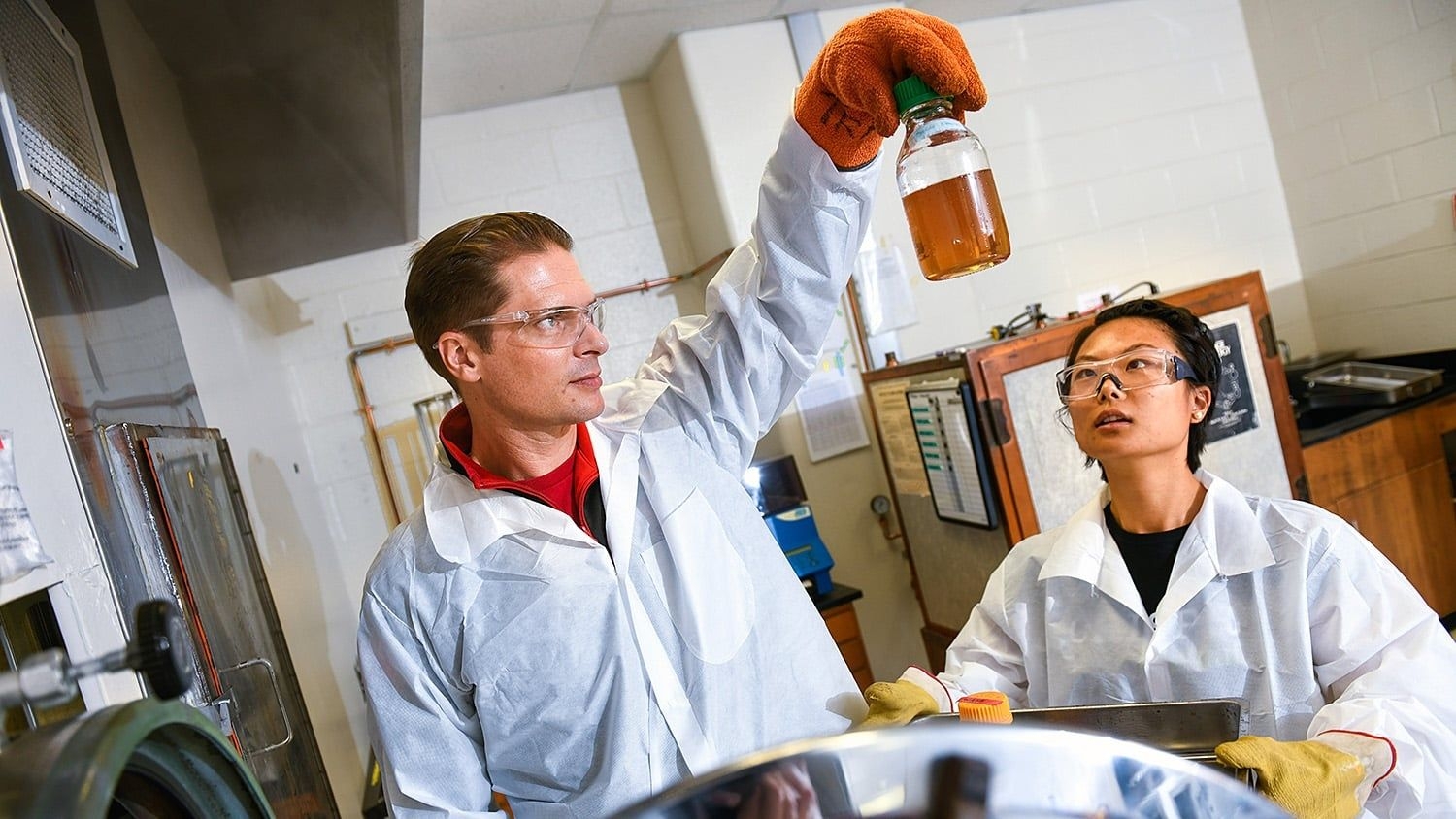A new Genome Editing Center for Sustainable Agriculture based in NC State University’s College of Agriculture and Life Sciences heralds a new era. To explain the potential and applications of genome editing, we asked NC State’s Rodolphe Barrangou, a pioneer in CRISPR technology. As the Todd R. Klaenhammer Distinguished Professor in probiotics research, Barrangou leads the CRISPR lab in the Department of Food, Bioprocessing and Nutrition Sciences.
Hundreds of millions of people worldwide have consumed Barrangou’s work. If you’ve eaten a spoonful of yogurt or a bite of cheese in the last decade, you’re among them. His research with Danisco to find better starter cultures for the dairy industry laid a foundation for CRISPR, a genome editing technology that can be applied in a wide range of fields, including food science, medicine, agriculture and forestry. As an entrepreneur, Barrangou has taken this revolutionary technology to market, co-founding five companies.
NC State’s College of Agriculture and Life Sciences will open a new Genome Editing Center. What’s the difference between genome editing and the gene editing that’s been going on for a long time?
It’s about scale. When we say gene editing, it’s kind of one edit in one gene. It’s editing much like an editor changes text. We’re editing the text of life in DNA and we’re changing letters in DNA, and we can add a word, remove a word, add a sentence, remove a sentence, or even a whole paragraph or a whole chapter.
With genome editing, it’s the whole genome — all of the genetic material. As a matter of fact, in plants that are complex organisms, the large majority of the genome is not genes, it’s noncoding regions. More often than not, we don’t just want to just change one gene, we want to change other things in the genome. Just as you can change a letter to change text, you can also change the punctuation. And genome editing allows us to not just change the genes, but to turn them on or turn them off and turn them up or turn them down. It’s called a transcriptional control. We can adjust the volume to make it louder or more quiet. We can change not just the gene itself, but how it’s used, how it’s transcribed, how it’s expressed — not just the content of the text, but the punctuation as well.
We can also change what’s called the epigenome. When the environment has an impact on an organism, oftentimes there are environmental cues like weather in crops. Heat, cold, frost, dryness, fire, chemicals, insects, viruses, fungi, humans, weather and smoke can change not just how genes turn on or off, but how some of that DNA is impacted. We can use CRISPR-based technologies now to change the genome, to use the transcriptional or volume control, and to change how environmental factors affect DNA.
You’re a pioneer in CRISPR technology, which recently celebrated a major milestone: The first patient completed new FDA-approved CRISPR gene therapy for sickle cell disease. Did you expect these kinds of developments?
We are ushering in a whole new era of CRISPR medicine that is going to transform the lives of patients afflicted by genetic diseases and create gene and cell therapies for patients with cancer. Already patients are benefiting from those disruptive, amazing, innovative technologies, which is great. But the reason we’re creating this new center based in the College of Agriculture and Life Sciences — and one of the reasons I’m at NC State — is that notwithstanding the great potential in terms of medicine, health and disease, we can impact a lot more people by deploying those technologies for food and agriculture.
There was genome editing before CRISPR — “BC,” as we call it — but it was slow. It was hard. It was difficult. It was expensive. It was very demanding. CRISPR technology has revolutionized that and democratized the technology.
How can genome editing improve people’s lives through food and agriculture?
When it comes to food and agriculture, the number of people who can be impacted by products derived through genome editing and the impact we can have on sustainable agriculture is remarkable. I always tell people by the end of the decade that maybe we’ll dose a million patients and save a million lives. That’s a lot of people. But by the end of the decade, I think we’re going to feed over a billion people with CRISPR-based products. That’s a lot of mouths.
How will food and agricultural scientists harness this technology to make that possible?
CRISPR enables much faster breeding. In crossing and mating crops and plants and trees, the timelines are long — sometimes decades. We can do in the lab the same thing that would happen in nature, up to 10 times faster. And the scale at which we can do genetic breeding is five to 10 times broader and deeper. We know a lot about genetics, genomes and data, and we can use AI and machine learning models to inform our breeding strategies. We can go into the genetic potential of any one crop and combine the best traits that exist into elite, commercially relevant germplasm. In tomatoes, we can take the best traits of heirloom tomatoes in terms of flavor and put those into tomatoes that have been bred to grow larger. We can take varieties that are very resilient but may not taste the best, and enhance their taste or nutritional attributes.
Last year a company called Pairwise Plants — it’s in RTP as a matter of fact — took the bitterness out of mustard greens. I brought my whole lab and did a taste trial. Now, I personally like some of those vegetables that are a little bit bitter and pungent, but some people don’t. If you can remove undesirable flavors in vegetables, can we get people to eat more vegetables? You can now scale that up to fruits and vegetables that are historically hard to breed. For example, many people really like seedless grapes. Imagine we can do that for a bunch of seedless berries. Imagine pitless cherries or pitless avocados. A lot of potential consumer-centric traits will be of interest to a large swath of the population.
Whether it’s about improving farmer yields, farmer benefits and farmland value, or satisfying consumers’ tastes, the possibilities are limitless. Arguably the only limitation is our imagination. It’s not our knowledge of genetics because this is really increasing exponentially. The last 10 years have changed the game, big time.
How does this help address challenges to agriculture such as environmental instability, invasive species and shrinking farmland?
There’s a lot of potential to bring next-generation breeding technologies to diverse crops, to increase biodiversity, sustainability and resilience, and then address two kinds of traits. One group of traits is improving yield and performance and one is about stress resilience. I mentioned frost, of course, and drought is very relevant with climate change. With environmental pest-induced issues, whether they’re insects or fungi or bacterial diseases or viral diseases, we can use genome-editing technologies to address the need for more resistant varieties and do that much more quickly.
There’s great potential to work on crops that are not easy to manipulate. We can increase biodiversity, availability and the types of crops that we work on. You can extend that all the way to livestock. We have a huge livestock industry in the Southeast in general, North Carolina in particular. We can use those approaches to breed pigs and hogs, or turkeys and chicken, or cattle for both dairy and beef.
We can customize feed and crops for weight gain or health of animals. Not just for humans, but for animals as well. As we think about the environment, supply chain and global impact, we can envision engineering the microbiome to lower methane emissions in cattle. There are all kinds of possibilities at all scales from large trees that will last a thousand years to microscopic viruses and bacteria that enhance the gut health of both humans and livestock.
Once the Genome Editing Center for Sustainable Agriculture is up and running, how do you expect to work with the scientists on campus?
The way we do science today is very collaborative. That’s how you make more impact. We have a lot of knowledge in genome editing, in CRISPR, in plant genetics, in plant breeding, in machine learning and data and genetics and analytics. That’s the rationale behind the N.C. Plant Sciences Initiative and the Plant Sciences Building. This is not new, right? We’ve done it before. We’ll continue to take it to the next level. We have to have the wisdom to recognize that some technologies are transformative, and we have to double down and create space where people who have common interests, complementary interests and overlapping interests can work together to be more than the sum of our parts.
Having that formal genome editing center, being more visible, will help unify a lot of efforts that we have on campus. And we want other scientists outside NC State to work with us, but we don’t want them to have to find the right faculty, in different departments and sometimes different colleges on campus. Having the center is about centralizing, becoming the connecting node and part of a whole network of people working on genome editing.
What is the most exciting aspect of the Genome Editing Center for you personally?
I think it’s having agriculture catch up with therapeutics and then go beyond. And I’m personally very passionate about the work that we’re doing in forestry, which has a huge impact on the economy in our state. Trees are maybe an underappreciated part of the plant world.
Some of the work that we’re doing here is very sophisticated, pioneering, ambitious. It will be impactful but will take a long time. I’m very excited about the work. And as a trainer and faculty member at NC State, we’re not just doing the work ourselves, we’re also training the next generation of scientists.
This post was originally published in College of Agriculture and Life Sciences News.
- Categories:



